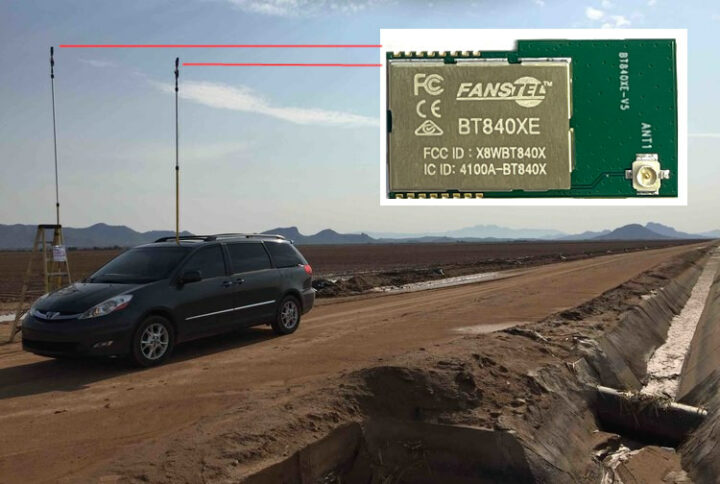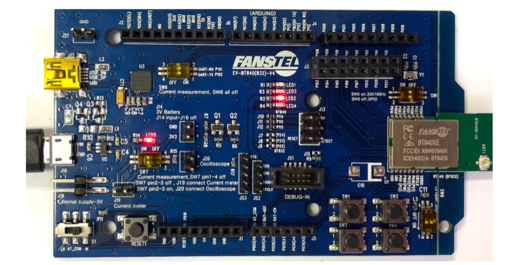Fanstel BT840XE is an nRF52840 Bluetooth 5.2 LE module with a power amplifier designed for transmission at over 4500 meters, and some deployments with two BT840XE modules and 0Dbi antennas even reach over 10 km.
At home, I can use my Bluetooth headset about 6 to 8 meters from my phone before the audio starts cutting, and most Bluetooth devices have an advertised 10-meter range, although Bluetooth class 2 devices could transmit up to 100 meters away. But with Bluetooth 5, the wireless standard improvement meant it was not possible to get four times the range, and/or some further extended the range of their hardware with a power amplifier as we’ve seen with the RFCat N32 board a few years ago.
Last week, I got contacted by a company called RF Star about a Texas Instruments CC2652P multi-protocol mobile with PA (power amplifier) that could achieve a range of 500 meters with BLE and 800 meters with Zigbee using a max Tx power of +20 dBm. While checking out more about Bluetooth range, I stumbled upon Fanstel BM833 Bluetooth 5.1 module based on nRF52833 SoC and with an estimated 3.4 km range with BLE at 125 Kbps, and +8.16 dBm power. That seemed odd, so I contacted Fanstel, and got an answer within a couple of days:
We measure Bluetooth range in the Arizona desert. Measurement methods are described in this webpage.
https://www.fanstel.com/testreport
The 3400-meter range was measured between a pair of BT840E with a 0 dBi antenna, ANT000. BM833E is a cost-reduced version of BT840E. The maximum transmission power measured by an FCC test lab is about the same. So, we estimate the range between two BM833E to be the same.
Bluetooth ranges without marking “est.” in the attached selection guides, are measured in the Arizona desert. The test site limits measurement to 2.8 miles/4500 meters. The range for BT840X/BT840XE (nRF52840 + PA) is marked as >4500 meters. One customer deploys two BT840XE + ANT000 at 11000 meters/7 miles apart.
Amazing! That means some company is using BLE modules to transmit data over a distance greater than 10 kilometers… If we follow the test report link we can better understand how it is done. Besides using Bluetooth Long Range at the lowest bitrate (125 Kbps) and a power amplifier, they made sure there was no obstruction inside 60% of the Fresnel zone radius, to prevent signal attenuation, by using antennas well above ground.
The test was conducted with different modules and antennas at different heights: 0.55 m, 1.52 m (typical height for thermostats), and the LMPI (Low Multiple Path Interference) height that is set to at least 60% of the Fresnel zone clearance. Here are the results for various modules testing in an area with a 3.2 km line-of-sight.
The antenna height made massive differences for the BT840F module (+8dBm power) with a range of just 210 meters at 55cm, going up to 640 meters with the antenna placed 1.52 meters high, and a massive 2.3 km at LMPI height (around 6 meters for 3.2km distance). RF Everything provides an online tool to calculate the Fresnel zone radius, and the LMPI height would be around 11.1 meters for the 11 km range. The BT840X module range with LMPI height and 125 Kbps could not be fully tested since the test site was too short!
For reference, let’s have a quick look at Fanstel BT840X/XE specifications:
- WiSoC – Nordic nRF52840 QIAA with Arm Cortex M4F core, 1MB flash, 256 KB RAM, support for BLE, ANT, Thread, Zigbee, NFC
- RF solution with integrated antenna
- BT840X: PCB antenna
- BT840XE: u.FL antenna connector
- Certified with ANT000 0dBi antenna – Link budget: 137 dB (between a pair of modules)
- Certified with ANT060 6 dBi antenna. Link budget: 129 dB (between a pair of modules)
- Power amplifier to increase TX power to +21 dBm and receiver sensitivity
- I/Os and peripherals
- 12 bit/200KSps ADC
- 3x SPI Master/Slave, 8 Mbps
- 2x 2-wire Master/Slave, I2C compatible
- UART
- Quadrature Demodulator (QDEC)
- I2S audio interface
- Digital microphone interface
- Peripherals – Temperature sensor, general comparator, Low power comparator, Random Number Generator
- 20 channel CPU independent Programmable Peripheral Interconnect (PPI)
- 5x 32-bit, 3x 24-bit Real-time Counters
- Security – 128-bit AES HW encryption
- Debugging – Serial Wire Debug (SWD)
- Supply Voltage – 1.7V to 5.5V
- Dimensions – 28 x 15 x 1.9mm
- Temperature Range – -40°C to +85°C
- Certifications – FCC, IC, CE, RCM
The BT840X module is sold for $12.50 in 1k quantities, while the BT840XE goes for $12.75, plus the antenna that adds $5 or $6.
The company also provides EV-BT840X and EV-BT840XE evaluation kits with two boards for $120 and $132 (including ANT060 antennas) respectively. More details about the modules and evaluation boards can be found on the product page.

Jean-Luc started CNX Software in 2010 as a part-time endeavor, before quitting his job as a software engineering manager, and starting to write daily news, and reviews full time later in 2011.
Support CNX Software! Donate via cryptocurrencies, become a Patron on Patreon, or purchase goods on Amazon or Aliexpress







